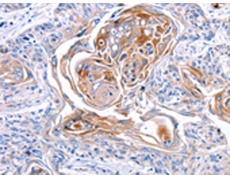|
Background: |
This gene encodes a large cytokine protein of 373 amino acids, it contains multiple domains and is the only known member of the CX3C chemokine family. It is also commonly known under the names fractalkine (in humans) and neurotactin (in mice).The polypeptide structure of CXC3L1 differs from the typical structure of other chemokines.CX3CL1 is produced as a long protein (with 373-amino acid in humans) with an extended mucin-like stalk and a chemokine domain on top. The mucin-like stalk permits it to bind to the surface of certain cells. However a soluble (90 kD) version of this chemokine has also been observed. Soluble CX3CL1 potently chemoattracts T cells and monocytes, while the cell-bound chemokine promotes strong adhesion of leukocytes to activated endothelial cells, where it is primarily expressed. CX3CL1 elicits its adhesive and migratory functions by interacting with the chemokine receptor CX3CR1. Its gene is located on human chromosome 16 along with some CC chemokines known as CCL17 and CCL22. |
|
Applications: |
ELISA, IHC |
|
Name of antibody: |
CX3CL1 |
|
Immunogen: |
Synthetic peptide of human CX3CL1 |
|
Full name: |
chemokine (C-X3-C motif) ligand 1 |
|
Synonyms: |
NTN, NTT, CXC3, CXC3C, SCYD1, ABCD-3, C3Xkine, fractalkine, neurotactin |
|
SwissProt: |
P78423 |
|
ELISA Recommended dilution: |
1000-10000 |
|
IHC positive control: |
Human esophagus cancer |
|
IHC Recommend dilution: |
25-100 |

 購物車
購物車 幫助
幫助
 021-54845833/15800441009
021-54845833/15800441009
